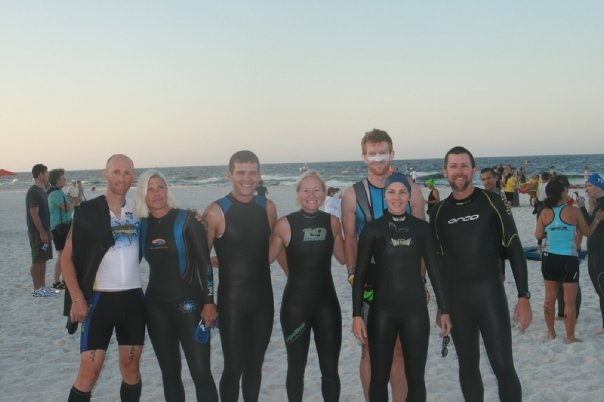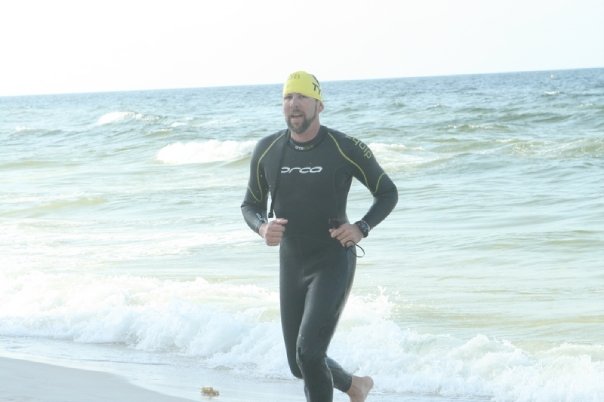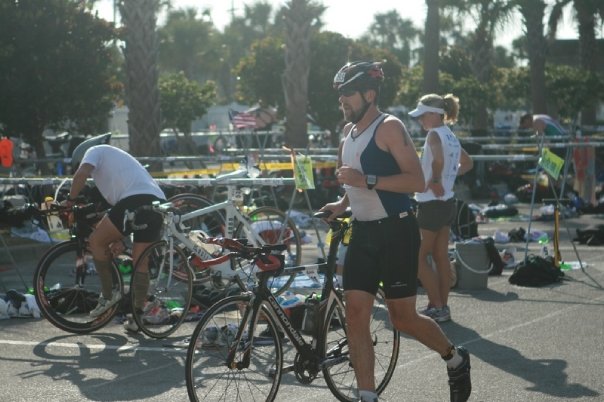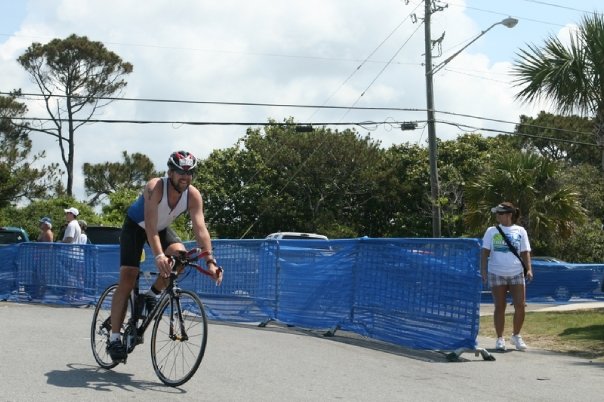I chose the Gulf Coast Triathlon as my first half-Ironman event, mostly because several friends from my triathlon club were also doing it. The event is held in Panama City Beach, Florida near Pensacola. I’m from Florida, so I’m not sure why I didn’t think about the fact that this is a race in a Florida beach community in May. Maybe that wasn’t the smartest of ideas for someone who dislikes racing in the heat, but by the time I thought through this, I had already paid the race entry and race day was quickly approaching.
Pre-Race
After falling asleep with no problem around 9:00, the alarm went off at 5:15 and I got up to make a bagel with peanut butter. I tried to get some Gatorade down with it but wasn’t all that thirsty. I grabbed my bag and headed down to the transition area for body marking. After getting my number printed on my arms and legs, I headed into the transition area to check my bike and lay out my gear. I like to lay my gear out, walk through using it once, and then lay it out again. It’s not that the order of things or their orientation ever changes, but I just like to do this. It’s become something of a ritual for me I suppose. I took my empty transition bag and my swim gear (cap and goggles) and headed back up to the hotel room, stopping to say ‘hello’ to my Hammerhead friends that were there for the race and wish them luck. The swim start is a running start in waves by age group. The first wave was at 6:15 and mine was not until 7:00 or so. Jen was awake by the time I got back up to the hotel room and had gotten dressed and gathered her camera equipment. We headed down to watch the swim starts and bumped into the rest of the Hammerheads along the way. The water temperature was 78° so we were able to wear wetsuits — thankfully.

After a few minutes of swimming out through the waves and back to shore a few times, I was warmed up and ready for my swim wave to start. I watched a few of my friends in the waves before mine head out, gave Jen a kiss, and walked to the swim start corral. The buoys didn’t really look too far out — I figured this couldn’t be as bad as I had thought during training.
Swim
When it was time for my wave to start, the group of 40 or so of us headed off into the surf and were immediately met by the smell of gas and oil. That’s not really what I expected, but given the number of athletes in the water, the only way to safely manage the swim course was by utilizing jet skis and power boats, both of which were sitting idle (and spewing fumes) during most of the event. The swim went about as well as I had expected. I stopped going to the pool a couple of months before the race and my only training was a couple of organized ocean swims, which is hardly sufficient. That said, I didn’t have high expectations and expected to finish the swim in around 46-48 minutes. I took a watch so that I could monitor my swim time at different points in the course. The course was set up such that you swam out to the 7th buoy on the west side, crossed over to the eastern side of the course and then swam back in past seven buoys on the east side of the course. I got out to the end of the buoys at just under 29 minutes and crossed over to the return side of the course. It’s worth pointing out that all the buoys that didn’t look like they were too far out appeared to have drifted farther out to see as I swam toward them. It took me about five minutes to swim over to the return side and start to head back in to shore. My swimming was as pathetic as I had feared; much of it was in breast- or backstroke. It seems that the discipline where I have the most trouble improving endurance is swimming, yet I pretty clearly avoided the pool for the last couple of months. I don’t need to be told that this makes no sense — it’s just plain stupid of me. However, I did do fairly well at sighting (keeping an eye on the buoy) and staying on course rather than straying off the shortest path around the buoys. I noticed a couple of guys swim by me with snorkels and I had to resist the urge to drown them. As I came in to shore, I caught a couple of waves to help me get in easier. I also tried to swim until I could basically touch the bottom with my hands. I didn’t realize that there was a sandbar before the water got deep again and then shore, so my smart effort to swim as far as possible (as opposed to trying to walk in waist-deep water was somewhat wasted as I waded from the sandbar (back into deeper water) to the shoreline. Regardless, I came out at about 51 minutes, not too far off from my estimate.

Transition 1
I was able to shed my wetsuit quickly and get into cycling gear within about 3:00 though I did take time to put some sunblock on, which is not something I usually do. I’ve worked at a few time-saving techniques in transition though I’m mostly concerned about this on short courses. I felt good about my transition time of 5:40 and ran out of T1 ready for the bike portion.
Bike

The out-and-back bike course does a short leg to the east of the transition area and then heads back west through town and then north where it turns around and follows the same route back. One of the roads (338) on which we travel are a little more rough than I would have expected and that was a pretty common complaint with many of the athletes. Fifty-six miles of this take a toll on your wrists and I can’t imagine doing the full 112 miles (Ironman Florida is here in November) on these roads. During the first few miles of the bike, I was a little surprised at how different being wet (from the swim) on the bike affected me. All of my previous triathlons had been in fresh water lakes and my brick workouts that involved an ocean swim did not include timely transitions (i.e. we changed and stood around for a few minutes while everyone got ready) so I wasn’t really still dripping with salt water when I got on the bike. It took a few minutes for the salt water to stop running into my mouth, and it was a noticeably different feel on my arms and legs compared to fresh water. Neither of these were a big deal, but the taste of salt water got old pretty quickly. I took my first gel only a mile or two into the bike portion on the assumption that my reserves were pretty heavily taxed from the swim. I also had two bottles of Gatorade on the bike and started hydrating immediately, partially in hopes of battling the taste of saltwater in my mouth. As I headed back past the transition area and out onto the better part of the bike course, I tried to settle into a rhythm that would keep me moving along at a good speed but not wear me down too much for the run. I had not swam this distance in training and so I was admittedly less familiar with what to expect from the effort than I should have been. I hadn’t practiced taking water bottles at water stops before, but this came fairly easily for me. It’s good that this didn’t present a problem, as failing to get water a stop when you’re out can ruin the rest of your bike portion (if you don’t go back) if it leads to hydration/nutrition issues. I didn’t lose more than one or two miles per hour in water stations and was able to get down quite a bit before ditching the bottle. If I had an AeroDrink bottle, I could make better use of the water at stations, or if I had left a bottle cage empty, but I didn’t think about that. Fortunately, I had enough fluids that by loading up after each water station, my hydration levels were fine. I managed to get two packages of Cliff Shot Blocks down during the bike course, which felt right at the time, but was probably a lot less calories than I should have taken in. There was a bit of a wind toward the north during the bike course, which caused a few different effects. During the part of the course that parallels the beach line, the side wind felt like a head wind. If you live in a beach area, and since this is the case whether it’s coming from the right or left, you know that this feels like a head wind in both directions. Also, the entire second half of the course was to the south so a head wind was present for most of the last hour or so. This gave me a slower average speed during the second half of the bike course with an overall average of 18.37 miles per hour.

Overall, the bike portion went fairly well and I came in at 3:03:41, having told my wife to expect me between 3:00 and 3:30. I was pleased with the time (lower speed goal than what I would have liked) and was ready to head out onto the run and get this over with. I saw my wife as I was coming into the dismount area and hearing her scream at me (she had noticed that I was a bit of ahead of schedule) really helped my energy levels. Looking back at it, there were a lot of spectators there that were cheering for everyone as they came through.
Transition 2
I went into T2 feeling pretty strong and fairly confident that I had enough gas to get through the run. I was able to get to the bike rack and change shoes fairly quickly, trading my spare tire tube in my shirt pocket for a couple of gels, and headed toward the run exit. I failed to add more sunblock, which would later prove to be a mistake. I opted to leave behind my Fuel Belt, as the Gatorade in them was at about the same temperature that I usually drink my coffee. My total time in T2 was 3:38.
Run
The run portion of this race is where everything fell apart for me. There was no shade on the course and while I thought I would be OK with this, it had more of an impact than I thought. I had not been running during the hotter parts of the day and so my body was not at all acclimated to running in the heat. This was May in the Florida panhandle and during the middle of the day. I don’t really know what I was thinking. I’ve dumped plenty of water over my head to stay cool during runs, especially marathons. I knew I would be dumping water today, but there was one small difference. I was wearing socks that I originally bought for running but now only wear when cycling. They have a little padding on the bottom of them and I never for a second thought they would wick moisture any differently than the other running socks I own. I was wrong. They apparently soak up water, meaning it was pooled at the bottom of my feet. Between miles 4 and 5, I was on track to come in around 6:15 or 6:20, which was just ahead of my goal. I began to notice that my feet felt gritty, like I had sand in my shoes. I knew from experience that once you begin to feel this, it’s already too late. Without a change of socks and with nothing to clean/dry my feet, there was nothing I cold go but keep going. By mile 7, I had 3-4″ blisters on the bottoms of both my feet and could barely walk. Just crossing a speed bump or a scattered pile of pebbles in the road was excruciating. I was reduced to walking the last six miles of the course on the heels of my feet and moving at about an 18:00 minute/mile pace. There was a state park in the middle of the run course which was the turnaround point — I thought that this meant some shade might be in store — I was wrong. It was a beachfront park that is all sand dunes and blacktop roads. So much for that! My typical 2:15 to 2:20 half-marathon turned into a three-and-a-half hour nightmare as my head and hands began to fry in the midday Florida sun. I had found an aid station where I could get sunblock, but I was still running at the time and only lathered my arms, not continuing any lower onto my hands. As I hobbled the last mile or so of the run course, I passed athletes that were leaving the Finish area and many of them had words of encouragement for me. It was helpful to hear that I was almost there and many of them assured me I could make it. About a quarter-mile from the end, I passed my friends, Beth and Kathy, who were walking back to their condo. Beth had experienced a problem during the swim and was not able to compete, whereas Kathy had just finished a while earlier. They encouraged me to keep going and off I went.
As I came into the Finish Line, I saw my wife who was yelling at me and gingerly (as the announcer at the Finish area described it) made my way across the timing mats and on to the volunteers with the medals. I asked one of them where I could find the medical tent and he pointed me in the right direction.

Post-Race
Many of my friends from the Hammerheads Triathlon Club were at the Finish area taking pictures. I missed them by only a few minutes, but was able to talk to a few of them before heading on to have my feet looked at by a nurse. I retrieved my bike from transition along the way, as I was pretty sure I would not be able to get shoes back on after I took them off. The visit to the medical tent didn’t really confirm anything surprising — I definitely had big blisters. What I didn’t realize was that they probably popped some time in the state park. I was hoping that if I took it easy with my weight distribution, perhaps I could finish without bursting them. I realized later how foolish that line of thought was. The reason they hurt so bad was because they had been popped. I managed to get down a couple pieces of pizza, three foot long chili dogs, some potato chips, and a soda before feeling like I needed to take a nap. I took a quick shower and passed out within seconds of hitting the pillow. It goes without saying that when you walk (“stroll” is probably a better descriptor) the run portion of a triathlon, you’re not likely to perform all that well in comparison with other athletes. In the swim, I was 110/117 and 925/1045. On the bike, I was 96/117 and 795/1045. In the end, I finished 109/117 in my age group and 902/1045 overall. Certainly not a good ranking within my age group or the overall field of athletes, but given the hellish experience on the run course, I can’t be too upset about it. And while it’s not the way I would hope anyone’s first half-Ironman goes, it certainly means the probability of improving on my next one is rather high. I can’t say that I will come back to race this course again. The timing of the event and location are a bad combination and the effect is measurable at the point in the race when you’re most susceptible to overheating. I’ve heard that Ironman Florida, which takes place in November is much better, but I don’t know. I certainly wouldn’t do this in May again. The bike and run courses both could have been of better quality, between the bad road surface in the bike portion and the fact that much of the run course was covered in sand or gravel. I think it’s also worth pointing out that we stayed at the Boardwalk Beach Resort, and while it’s probably not any worse than the other hotels in the area, we found it to be of much lower quality than we would have expected for the cost per night. It was, however super-convenient for the triathlon itself, as the swim started behind our hotel, the transition area was next to it, and the Finish Line was in front of it.


